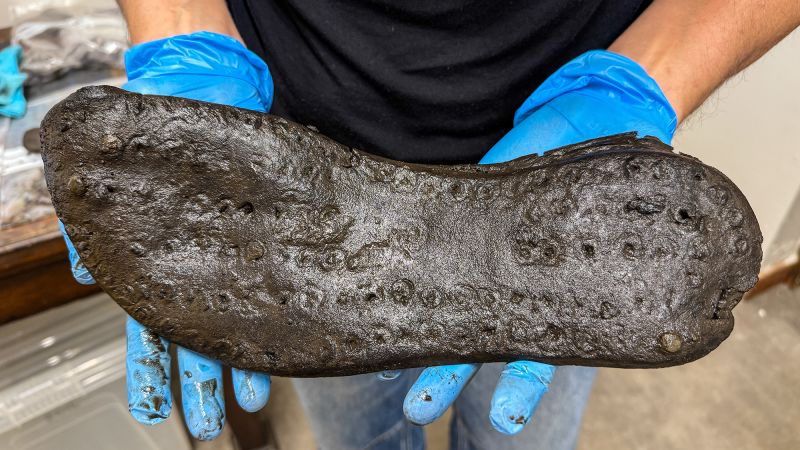An intriguing puzzle centred on ancient Rome is currently unfolding amidst the picturesque hills of northern Britain. Archaeologists working at the remnants of a first-century military fort located along Hadrian’s Wall have made a remarkable discovery—a trove of unusually sized footwear. Hadrian’s Wall, which spans an impressive 73 miles (117 kilometers), served as a crucial defensive structure that shielded the Roman Empire’s northwestern frontier from various foreign adversaries. This recent find is prompting scholars to reevaluate what life was like for the inhabitants of this fort.
The excavation site, known as Magna Fort, yielded 34 pieces of footwear in May, which includes not only robust work boots but also child-sized shoes. This assortment of shoes is providing valuable insights into the lives of the approximately 4,000 men, women, and children who once populated this strategic location just south of the Scottish border. Among the notable items discovered are eight pairs of shoes measuring over 11.8 inches (30 centimeters) in length, which equates to a US men’s size 13.5 or higher based on Nike’s size chart. Such dimensions significantly surpass contemporary norms, leading to speculation regarding the possibly tall stature of the soldiers stationed at this frontier fortification.
In striking contrast, the average shoe found at a neighboring Roman fort was sized closer to a US men’s size 8, showcasing the peculiar nature of the findings at Magna Fort. Senior archaeologist Rachel Frame, who is spearheading the excavation, recalled the initial reaction to uncovering the first large shoe. The team conjectured that they might be winter shoes, or perhaps worn by individuals who stuffed them with extra socks. However, as more sizes surfaced, it became increasingly clear that these were simply worn by individuals with notably larger feet than average.
As the excavation efforts progress, Frame expresses a desire to unearth more information regarding the identities of those who wore these giant shoes. Currently, a foundational understanding of the site’s historical narrative is beginning to materialize. Archaeologists surmise that various Roman military units, alongside their families, occupied Magna Fort intermittently, beginning around AD 85, shortly after its construction. Inscriptions revealing the presence of Hamian archers from present-day Syria, Dalmatian mountain soldiers from Croatia and Serbia, and Batavian warriors from the Netherlands hint at a multicultural populace. Nevertheless, the duration of each group’s stay remains undisclosed.
The soldiers assigned to this post often embarked on distant missions, potentially discarding shoes and clothes in the nearby trenches in their haste, as Frame describes. Furthermore, new occupants would typically construct larger accommodations on top of the existing structures, thereby entombing the possessions left by previous residents under layers of debris and clay. Frame’s sentiments about archaeological finds resonate with many in the field; she notes that remnants of daily life can reveal volumes about the people who left them behind.
Dr. Elizabeth Greene, an associate professor at the University of Western Ontario, also emphasizes the significance of such artifacts. Her research at the nearby Vindolanda Roman Fort has included the examination of thousands of shoes, providing a comparative backdrop for the Magna discoveries. Notably, the ancient footwear from both sites shares construction methods, featuring thick cowhide leather soles fastened with iron hobnails. While many of the Magna shoes lacked complete upper portions, Vindolanda’s collection encompasses a broader variety of styles, from closed military boots to sandals crafted with leather fasteners.
The extraordinary size of the shoes uncovered in the Magna excavation suggests the original wearers were exceptionally tall, a noteworthy distinction compared to Vindolanda, where only a minor fraction of the shoes highlighted a similar size. In ancient Roman military texts, the ideal recruit stood at a height of approximately 5 feet, 8 inches to 5 feet, 9 inches. Nonetheless, the diverse origins of soldiers stationed at Hadrian’s Wall contributed to a wide array of physical attributes among the fort’s residents.
While the need for taller troops specifically at Magna Fort remains ambiguous, ongoing investigations aim to uncover telling details about the shoe owners. Frame proposes analyzing the footwear for signs of wear, as any foot impressions could potentially allow researchers to model the original wearers’ feet. However, linking these artifacts to actual human remains poses significant challenges. Inhabitants of this region typically practiced cremation, complicating the connection between the shoes and any existing skeletal remains. As Frame attests, the delicate bones unearthed thus far do not provide the clarity they seek.
Urgency surrounds their efforts, as the environmental conditions crucial for preserving these organic remains are changing rapidly due to climate shifts, impacting the soil’s oxygen levels. The 2,000-year-old leather artifacts recovered from Vindolanda remain in better condition than those found at Magna, a testament to the deteriorating underground climate. Frame articulates that the increased variations in weather patterns accelerate decomposition processes, thus amplifying the importance of swift excavation.
In the end, Frame advocates for a broader approach to archaeology, one that celebrates












